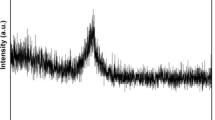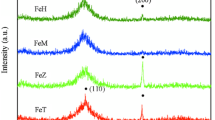Abstract
Bulk metallic glass forms when liquid metal alloys solidify without crystallization. In the search for iron-based bulk glass-forming alloys of the metal–metalloid type (Fe–B- and Fe–C-based), crystals based on the structural prototype C6Cr23 often preempt the amorphous phase. Destabilizing this competing crystal structure could enhance glass formability. We carried out first-principles total energy calculations of enthalpy of formation to identify third elements that can effectively destabilize C6Cr23. Yttrium appears optimal among transition metals, and rare earths also are suitable. Atomic size is the dominant factor.
Similar content being viewed by others
References
V. Ponnambalam, S.J. Poon, G.J. Shiflet, V.M. Keppens, R. Taylor, and G. Petculescu: Synthesis of iron-based bulk metallic glasses as nonferromagnetic amorphous steel alloys. Appl. Phys. Lett. 83, 1131 (2003).
V. Ponnambalam, S.J. Poon, and G.J. Shiflet: Fe-based bulk metallic glasses with diameter thickness larger than one centimeter. J. Mater. Res. 19, 1320 (2004).
Z.P. Lu, C.T. Liu, J.R. Thompson, and W.D. Porter: Structural amorphous steels. Phys. Rev. Lett. 92, 245503 (2004).
M. Mihalkovic and M. Widom: Cohesive energies of Fe-based glass-forming alloys. Phys. Rev. B 70, 144107 (2004).
T. Egami and Y. Waseda: Atomic size effect of the formability of metallic glasses. J. Non-Cryst. Solids 64, 113 (1984).
D.B. Miracle and O.N. Senkov: Topological criterion for metallic glass formation. Mater. Sci. Eng. A 347, 50 (2003).
G. Kresse and J. Furthmuller: Efficient iterative schemes for ab initio total-energy calculations using a plane-wave basis set. Phys. Rev. B 54, 11169 (1996).
G. Kresse and J. Hafner: Ab initio molecular dynamics for liquid metals. Phys. Rev. B 47, RC558 (1993).
P. Blochl: Projector augmented-wave method. Phys. Rev. B 50, 17953 (1994).
G. Kresse and D. Joubert: From ultrasoft pseudopotentials to the projector augmented-wave method. Phys. Rev. B 59, 1758 (1999).
J.P. Perdew and Y. Wang: Accurate and simple analytic representation of the electron-gas correlation energy. Phys. Rev. B 45, 13244 (1992).
S.H. Vosko, L. Wilk, and M. Nusair: Accurate spin-dependent electron liquid correlation energies for local spin density calculations: A critical analysis. Can. J. Phys. 58, 1200 (1980).
E. Moroni, G. Kresse, J. Hafner, and J. Furthmuller: Ultrasoft pseudopotentials applied to magnetic Fe, Co and Ni: From atoms to solids. Phys. Rev. B 56, 15629 (1997). M. Widom et al.: Stability of Fe-based alloys with structure type C6Cr23 J. Mater. Res., Vol. 20, No. 1, Jan 2005 241
Structure and energy data is available on the Internet at http:// alloy.phys.cmu.edu.
P. Villars: Pearson’s Handbook, Desk Edition (ASM International, Materials Park, OH, 1997).
C.B. Barber, D.P. Dobkin, and H.T. Huhdanpaa: The Quickhull algorithm for convex hulls, ACM Trans. Math. Software 22, 469 (1996), see web site http://www.qhull.org
Binary Alloy Phase Diagrams, edited by T.B. Massalski, H. Okamoto, P.R. Subramanian, and L. Kacprzah: (ASM International, Materials Park, OH, 1990).
Desk Handbook: Phase Diagrams for Binary Alloys, edited by H. Okamoto (ASM International, Materials Park, OH, 2000).
K.A. Gschneidner and F.W. Calderwood: The C-Y system. Bull. Alloy Phase Diag. 7, 564 (1986).
H. Okamoto: C-Y. J. Phase Equilibria 17, 548 (1996).
P. Villars, A. Prince, and H. Okamoto: Handbook of Ternary Alloy Phase Diagrams (ASM International, Materials Park, OH, 1995).
R.E. Watson and L.H. Bennett: Crystalline and glassy phases of transition-metal-metalloid systems. Phys. Rev. B 43, 11642 (1991).
W.H. Wang, Z. Bian, P. Wen, and M.X. Pan: Role of addition in formation and properties of Zr-based bulk metallic glasses. Intermetallics 10, 1249 (2002).
Author information
Authors and Affiliations
Corresponding author
Rights and permissions
About this article
Cite this article
Widom, M., Mihalkovic, M. Stability of Fe-based alloys with structure type C6Cr23. Journal of Materials Research 20, 237–242 (2005). https://doi.org/10.1557/JMR.2005.0028
Received:
Accepted:
Published:
Issue Date:
DOI: https://doi.org/10.1557/JMR.2005.0028




